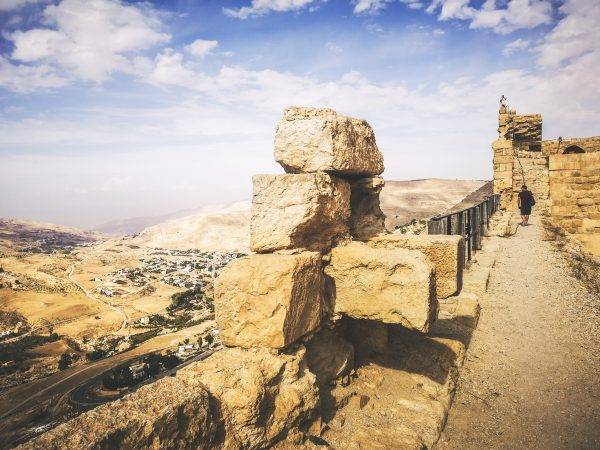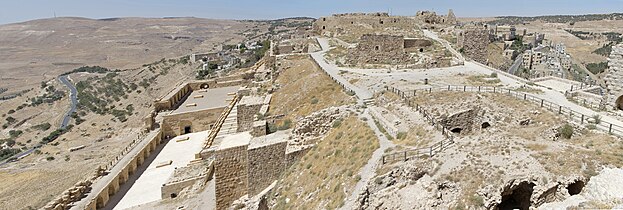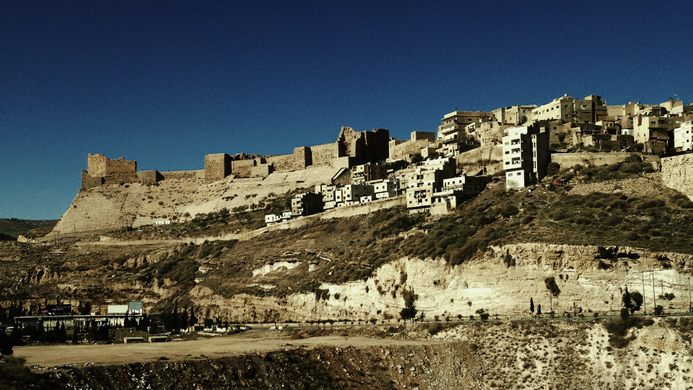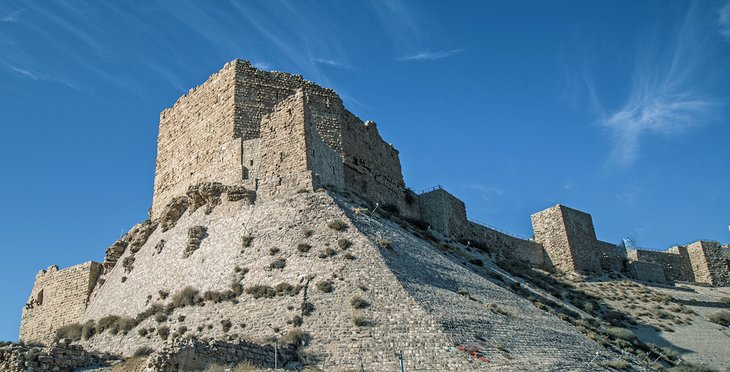Kerak Castle: A History of Power and Intrigue
Step back in time and embark on a journey through the captivating history of Kerak Castle. Situated in the Levant region of the Middle East, this magnificent fortress is a testament to the power and intrigue that defined the Crusader era.
From its construction in the 11th century to its tumultuous battles and eventual conquest, Kerak Castle symbolises resilience and determination. Join us as we uncover this ancient stronghold's fascinating stories and historical significance.

Introduction to Kerak Castle
A brief overview of Kerak Castle's Location and historical significance
Located in southern Jordan, Kerak Castle is an ancient fortress with a rich history dating back to Byzantine. Perched atop a hill overlooking the surrounding landscape, the castle was an important defensive stronghold and played a significant role in the region's history.
Built during the 12th century, Kerak Castle was strategically positioned along the King's Highway, an ancient trade route connecting Egypt to Syria. Its location made it a crucial outpost for trade and military operations, allowing those controlling the castle to exert power and influence over the region.
Throughout its history, the castle witnessed numerous conflicts and power struggles, including clashes between the Crusaders and Muslim armies during the Crusades. The castle changed hands several times between different factions, and its formidable defences played a crucial role in defending against sieges.
Kerak Castle is known for its impressive architectural features, including its massive walls, deep moat, and underground passages. It was designed to withstand attacks and protect its inhabitants during the conflict.
Today, Kerak Castle is a testament to the region's tumultuous past and is a major tourist attraction, drawing visitors from around the world. Exploring its ancient halls and envisioning the battles and intrigues within its walls provides a fascinating glimpse into the history of power and intrigue in the Middle East.

Importance of Kerak Castle in the Context of the Region
Kerak Castle holds great historical significance in the region. Situated on a hilltop in Jordan, it played a crucial role in controlling trade routes and defending against invasions. The castle's strategic location overlooking the Dead Sea and the surrounding valleys made it a formidable stronghold.
During the Crusades, Kerak Castle became a vital point of contention between Christian and Muslim forces. Its position allowed it to control key trade routes between Egypt, Damascus, and the Mediterranean coast. Several notable events and figures are associated with the castle during this period, including the infamous Reynald de Chatillon, who used the castle as a base for launching raids against Muslim caravans.
Besides its military significance, Kerak Castle also served as a centre of political power. Rulers and warlords sought control over the castle, leading to power struggles and political intrigues. The castle's thick defensive walls, underground passageways, and numerous towers exemplify the fortress's defensive architecture and the importance of maintaining control over the surrounding territories.
Today, Kerak Castle is a testament to the region's rich and complex history. Visitors can explore its well-preserved ruins, marvel at its architectural features, and learn about the power struggles and intrigues that took place within

Origins and Construction of Kerak Castle
The Origins of Kerak Castle and its historical background
Kerak Castle holds a rich historical background that dates back centuries. Its origins can be traced to the early Byzantine period, around the 4th century AD. The castle was strategically built on a hilltop in Jordan, overlooking the surrounding landscape and serving as a defensive stronghold.
Initially, Kerak Castle was constructed as a defensive fortress to protect the region from invading forces. Over the years, it underwent several expansions and renovations under different rulers and empires, including the Crusaders and the Mamluks.
During the Crusader period, Kerak Castle played a crucial role as a key stronghold and a centre of power in the region. It was strategically positioned on the trade routes between Egypt, the Levant, and Europe, making it a coveted prize for various Crusader armies.
Notable historical events and figures associated with Kerak Castle include the likes of the famous Crusader king, Reynald of Chatillon, who ruled over the castle and caused tensions with the neighbouring Muslim forces. The castle also witnessed numerous power struggles and political intrigues among ruling factions, including the Crusaders, the Muslim armies, and local Bedouin tribes.
Today, Kerak Castle is a testament to the region's rich history and offers visitors a glimpse into the dynamic and complex power dynamics that shaped the area during the medieval period. Its architectural features, including its imposing defensive walls, towers, and underground passageways, give insights into the castle's military significance and the defensive strategies employed throughout its history.

The construction and architectural features of the castle
The construction of Kerak Castle is a testament to its builders' architectural skills and strategic planning. The castle is on a rocky outcrop, providing natural defences against potential invaders. Its design incorporates Islamic and Crusader architectural elements, reflecting the region's diverse history.
The castle consists of multiple concentric walls, with the outermost wall enclosing an area of approximately 3.5 acres. The walls are made of thick limestone blocks, which were meticulously cut and fitted together. Solid construction and strategic positioning made it extremely difficult for attackers to breach the defences.
At the castle's heart is a massive central keep, surrounded by smaller towers and chambers. The keep was the last line of defence, housing essential facilities such as the lord's residence, storage areas, and a cistern for water storage. The architecture of these structures showcases the advanced engineering techniques of the time.
One notable feature of Kerak Castle is its network of underground passages, tunnels, and secret chambers. These hidden passageways provided the castle's inhabitants with escape routes and allowed for surprise attacks on enemy forces. The castle also had provisions for defence mechanisms such as arrow slits, murder holes, and a drawbridge.
Overall, the construction and architectural features of Kerak Castle highlight its importance as a defensive stronghold and showcase the ingenuity of its builders. Today, the castle stands as a historical monument, providing visitors a glimpse into the region's rich past.

Role of Kerak Castle in Crusader History
Kerak Castle during the time of the Crusaders
During the Crusaders, Kerak Castle served as a crucial stronghold in the region. Located in present-day Jordan, it strategically defended the Crusader states and controlled trade routes. The castle was strategically positioned on a hilltop, providing its occupants a commanding view of the surrounding landscape.
Kerak Castle was originally built by the Crusader ruler Pagan the Butler in the 1140s. It was a centre of power and a stronghold against potential Muslim attacks. The castle's formidable defensive features, including massive walls, strong towers, and a deep moat, made it difficult for enemy forces to breach its defences.
The castle witnessed several notable events and figures during the Crusader period. One such event was a siege in 1183 by the forces of Saladin, the renowned Muslim leader. The siege lasted for several months but ultimately ended in a truce. The castle changed hands between Crusaders and Muslims multiple times until it was finally recaptured by the Muslims in 1189.
Power struggles and political intrigues were a common occurrence at Kerak Castle. Rival factions within the Crusader camp often vied for control, leading to internal conflicts and betrayals. Notable rulers such as Raynald of Châtillon and Reginald of Kerak were associated with the castle and its intrigues.
The defensive mechanisms employed at Kerak Castle were impressive. It had multiple lines of defence, including a drawbridge, a barbican, and strategically placed towers. The castle's location on a rocky hill made it even more difficult for besiegers to mount an effective attack.
Overall, Kerak Castle is a testament to the power struggles and turbulent history of the Crusader period, serving as a tangible reminder of the grit and determination of the factions involved.

The strategic importance of Kerak Castle during the Crusades
During the Crusades, Kerak Castle played a crucial role as a strategic stronghold in the region. The castle was situated in present-day Jordan and strategically positioned along the trade routes between Damascus and Egypt. Its location atop a hill provided a vantage point that allowed control over the surrounding valleys and roads.
The castle's strategic importance was evident during the Crusades, as it served as a key defensive base for the Crusaders. Its strong fortifications and imposing presence were a deterrent against invaders and allowed the Crusaders to maintain control over the region. The castle's location also made it an ideal stopover for pilgrims travelling to the Holy Land.
Kerak Castle was a target for numerous sieges and attacks during the Crusades. It withstood multiple attempts by Muslim armies to take control of the region, and its resistant defence earned it a reputation as one of the most formidable fortresses of the time.
Notable events associated with Kerak Castle during the Crusades include the involvement of famous figures such as Raynald of Châtillon, who used the castle as a base for launching raids on Muslim caravans, ultimately contributing to the Second Crusade outbreak.
Overall, the strategic importance of Kerak Castle during the Crusades cannot be overstated. Its position as a defensive stronghold and its control over the trade routes made it a vital asset for the Crusaders and a thorn in the side of their adversaries.
| Strategic Importance of Kerak Castle during the Crusades | |
|---|---|
| 1 | Positioned along trade routes between Damascus and Egypt |
| 2 | Provided control over surrounding valleys and roads |
| 3 | Served as a defensive base for the Crusaders |
| 4 | Acted as a deterrent against invaders and maintained control over the region |
| 5 | Ideal stopover for pilgrims travelling to the Holy Land |
| 6 | Withstood Muslim attacks and sieges, earning a reputation as one of the most formidable fortresses of the time |
| 7 | Key figures such as Raynald of Châtillon used the castle to launch raids on Muslim caravans, contributing to conflicts |
| 8 | Contributed to the outbreak of the Second Crusade |

Notable events and figures associated with the castle during this period
During the time of the Crusaders, Kerak Castle played a crucial role in the region's complex political and military landscape. It was a strategically important stronghold that witnessed several notable events and was associated with key historical figures.
One notable event was the Siege of Kerak in 1183, led by the renowned Muslim military leader Salah ad-Din (Saladin). The castle was held by Reynald of Châtillon, a Crusader lord known for his aggressive actions against both Muslims and Christians. The siege lasted for several months, showcasing the castle's resilience and the determination of its defenders. Although the fortress ultimately fell to Saladin's forces, the defence of Kerak became legendary and elevated its reputation throughout the region.
Another noteworthy figure associated with Kerak Castle is the famous Crusader ruler Raynald of Châtillon. His ruthless actions and repeated attacks on Muslim caravans escalated tensions with Saladin and played a significant role in his decision to besiege the castle.
Kerak Castle's historical significance is further enhanced by its association with other prominent Crusaders, such as King Baldwin I of Jerusalem and King Amalric I. Their involvement in conflicts and power struggles in the region adds depth to the castle's history and showcases its importance during this period.
Overall, the events and figures associated with Kerak Castle during the Crusader period highlight its central role as a strategic stronghold and its connection to the broader historical context of the region.

Intrigues and Power Struggles at Kerak Castle
Stories of power struggles and political intrigues at Kerak Castle
Kerak Castle, located in Jordan, has a rich history of power struggles and political intrigues. One notable story revolves around Renaud de Châtillon, a Templar knight who ruled the castle during the 12th century. Known for his controversial actions, Renaud raided and pillaged trade caravans passing through the region, angering Islamic and Christian factions.
This led to conflict with the renowned Muslim military leader Saladin, who ultimately laid siege to Kerak Castle. The siege lasted for several years, during which time Renaud displayed his defiance by mocking Saladin and launching daring counterattacks. Eventually, in 1188, Renaud was captured by Saladin's forces, marking the end of his tumultuous reign at Kerak Castle.
Another notable figure associated with intrigue at Kerak Castle is Al-Sa'id Ibn Muzayyin, a 13th-century rival lord. Al-Sa'id cunningly infiltrated the castle by disguising his men as merchants and overthrew the ruling lord. These power struggles demonstrate the castle's significance as a strategic stronghold and the lengths individuals would go to gain control of such a crucial site.
Kerak Castle's history is filled with tales of political manoeuvring and power struggles, providing a fascinating glimpse into the complexities of the region's past. The castle's strategic location made it a highly coveted prize, leading to countless conflicts and intrigues throughout the centuries.

Notable rulers, warlords, and conflicts related to the castle
Kerak Castle has been the stage for numerous power struggles and conflicts throughout its history. Notable rulers and warlords have left their mark on the castle, shaping its history and adding to its intrigue. Here are some key figures and conflicts associated with Kerak Castle:
-
Reynald de Châtillon: A prominent Crusader leader, Reynald de Châtillon became the Lord of Kerak in the 12th century. Known for his aggressive actions against Muslims and Christians, Reynald's rule was marked by constant conflicts and raids.
-
Salah ad-Din (Saladin): One of the most famous Muslim leaders in history, Saladin launched a series of campaigns to regain control of the Holy Land from the Crusaders. Kerak Castle became a key target of his military campaigns.
-
The Battle of Hattin: 1187 Saladin laid siege to Kerak Castle, leading to the famous Battle of Hattin. The Crusader forces, including the Knights Templar and Hospitallers, suffered a crushing defeat, leading to the fall of Jerusalem to Saladin.
-
The Mamluks: After the decline of the Crusader states, the Mamluks, a powerful slave army, took control of Kerak Castle and used it as a base for their operations. They played a significant role in preserving and maintaining the castle.
The conflicts and power struggles associated with Kerak Castle highlight its strategic importance and its pivotal role in the region's history. Today, as a well-preserved historic site, Kerak Castle stands as a testament to the rich history of the Crusades and the struggles for power in the Middle East.
Kerak Castle as a Defensive Fortification
Defence Mechanisms and strategies employed at Kerak Castle
Kerak Castle, located in Jordan, was strategically built to serve as a defensive stronghold. Its position on a hilltop offered a commanding view of the surrounding landscape, making it an ideal defensive fortification. The castle employed various defence mechanisms and strategies to protect itself from enemy attacks:
-
Thick Walls: Kerak Castle's walls were constructed using large limestone blocks, making them difficult to penetrate. The walls were reinforced with numerous towers to provide additional defensive positions.
-
Moat and Drawbridge: A deep moat surrounded the castle, acting as a physical barrier that made it challenging for enemies to approach the walls. A drawbridge provided access across the moat and could be raised to prevent enemy entry.
-
Arrow Slits and Murder Holes: Arrow slits were narrow openings in the walls that allowed defenders to shoot arrows at attackers while remaining protected safely. Murder holes were in the ceilings through which defenders could pour boiling oil or drop heavy objects on enemies below.
-
Bastions and Ramparts: Kerak Castle featured bastions and ramparts along its walls, providing elevated positions for archers and catapults. These vantage points allowed defenders to target any incoming threats effectively.
-
Hidden Passages and Secret Rooms: The castle also had hidden passages and secret rooms that allowed defenders to move undetected within the castle and launch surprise attacks on intruders.
Kerak Castle's defensive features and strategies played a crucial role in its history, enabling it to withstand numerous sieges and preserve its position as a symbol of power and strength in the region.
